The most egregious manipulation is the text of the ballot language itself.
According to the Citizens Not Politicians Amendment group that proposed it, Issue 1 will:
- Create a 15-member Ohio Citizens Redistricting Commission made up of Democratic, Republican, and Independent citizens who broadly represent the different geographic areas and demographics of the state.
- Ban current or former politicians, political party officials and lobbyists from sitting on the commission.
- Require fair and impartial districts by making it unconstitutional to draw voting districts that discriminate against or favor any political party or individual politician.
- Require the commission to operate under an open and independent process.
You can read the full text of Issue 1′s ballot language as proposed by Citizens Not Politicians on their website, citizensnotpoliticians.org.
The official language that will appear on your ballot, however, is almost comically the opposite of the proposed language and inserts clear, political attacks against it. It reads that the proposed amendment would (emphasis our own):
- Repeal constitutional protections against gerrymandering approved by nearly three-quarters of Ohio electors participating in the statewide elections of 2015 and 2018, and eliminate the longstanding ability of Ohio citizens to hold their representatives accountable for establishing fair state legislative and congressional districts.
- Establish a new taxpayer-funded commission of appointees required to gerrymander the boundaries of state legislative and congressional districts to favor either of the two largest political parties in the state of Ohio, according to a formula based on partisan outcomes as the dominant factor, so that:
- Each district shall contain single-member districts that are geographically contiguous, but state legislative and congressional districts will no longer be required to be compact; and
- Counties, townships and cities throughout Ohio can be split and divided across multiple districts, and preserving communities of interest will be secondary to the formula that is based on partisan political outcomes.
- Require that a majority of the partisan commission members belong to the state’s two largest political parties.
- Prevent a commission member from being removed, except by a vote of their fellow commission members, even for incapacity, willful neglect of duty or gross misconduct.
- Prohibit any citizen from filing a lawsuit challenging a redistricting plan in any court, except if the lawsuit challenges the proportionality standard applied by the commission, requirements pertaining to an incumbent elected official’s residence, or the expiration of certain senators’ terms, and then only before the Ohio Supreme Court.
This continues for several pages (it’s a long amendment).
It is disgraceful that the Ohio Supreme Court upheld ballot language that so obviously insults the intelligence of Ohioans. Further, the Issue 1 petition language was already scrutinized and approved by Ohio Attorney General Dave Yost, who attested that the campaign’s summary of its own amendment was indeed an accurate interpretation.
This behavior isn’t new, but the latest in a pattern we have come to expect from statewide GOP leaders when they feel their stranglehold on power is challenged.
Just this week, the Ohio Supreme Court decided along party lines that those delivering absentee ballots for disabled voters and family members won’t be allowed to use drop boxes, affirming a directive by Secretary of State Frank LaRose.
We agree with the dissenting opinion of the court that “the directive adds one more unnecessary challenge to overtaxed caregivers, encouraging them to throw up their hands and say, ‘I don’t have time for this,” making the act of voting more difficult, instead of less, to combat an issue that doesn’t appear to exist.
“We love drop boxes. We think they are very safe and secure and do not want to see their use curtailed. In fact many counties would like to see them expanded,” said Aaron Ockerman, executive director of the Ohio Association of Election Officials. “We have not seen any evidence that they are problematic.”
And last year, many of the same state leaders used similar tactics with an August special election held for an issue that would have raised the necessary threshold of citizen-initiated amendments to pass. It failed, and the November abortion issue it was transparently intending to preempt, 2023′s Issue 1, succeeded, despite attempts to mischaracterize the issue via ballot language.
State leaders didn’t learn their lesson.
Fortunately, Ohio voters have seen through these machinations in the past, and they appear to be unphased by them now. According to a recent Bowling Green State University poll, 60% of Ohioans polled said they were in favor of Issue 1 and only 20% were opposed, with 20% unsure.
To be clear, this editorial is not an endorsement of Issue 1. It is a condemnation of the politicians who have chosen to deceive their constituents. Secretary of State Frank LaRose, the conservative majority of Ohio’s Supreme Court, Governor DeWine, Attorney General Dave Yost and many others who have been entrusted by the voters of Ohio with running fair elections should be held accountable for their actions.
It should be all Ohioans’ goal to see their legislative districts drawn to best represent the will of the voting public. For years, we have documented how gerrymandering undercuts that will and distorts our state politics, making it less representative and more politically extreme.
Gerrymandering is a complex problem and the solutions proposed by Issue 1 are complicated and not easily understood. We encourage you to read our explainer on Issue 1 that includes how its Redistricting Commission would operate and how its members are chosen.
Two amendments in the past nine years have attempted to address gerrymandering and have clearly failed, but the urgency to fix the problem remains.
We cannot definitively say whether this year’s amendment will be different and we will not tell our readers how to vote this November — but we will always stand up for your right to be informed about the issues on the ballot.
About the Author

